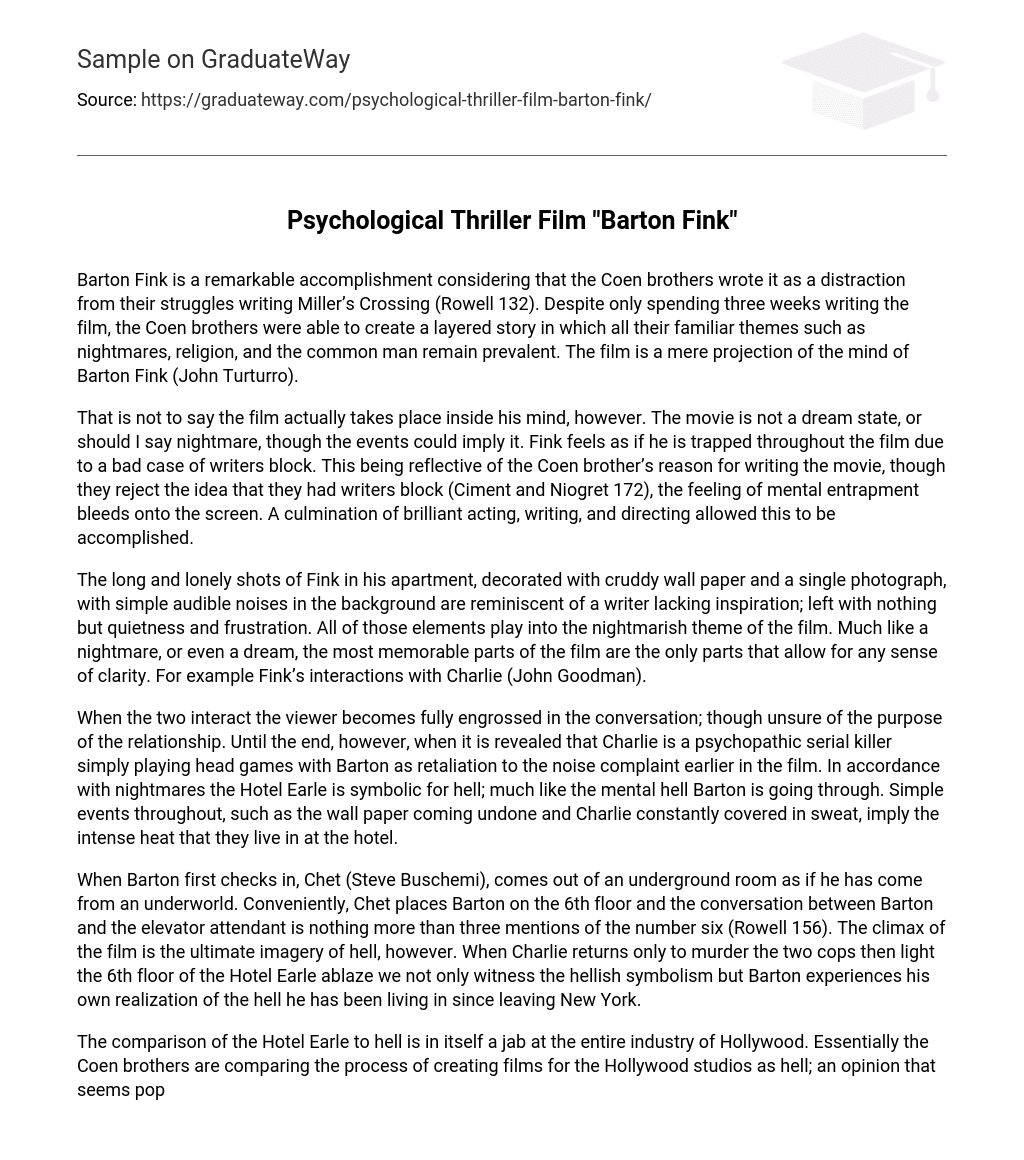Barton Fink is an impressive achievement in light of the fact that the Coen brothers crafted it as a diversion while facing difficulties in writing Miller’s Crossing (Rowell 132). Despite dedicating only three weeks to this endeavor, the Coen brothers managed to construct a multilayered narrative that upholds their recurring motifs of nightmares, religion, and the ordinary individual. Essentially, the film acts as a reflection of Barton Fink’s psyche (John Turturro).
While the film may give the impression of taking place inside the main character’s mind, it is not actually set in a dream state or nightmare. However, Fink’s constant struggle with writers block creates a sense of being trapped throughout the movie. The Coen brothers deny experiencing writers block themselves, but their intention was to capture the feeling of mental entrapment on screen. This was achieved through the combination of stellar acting, writing, and directing.
The apartment scenes depicting Fink, his dilapidated wallpaper and solitary photograph, along with subtle background noises, create the impression of a writer lacking inspiration, confined in silence and frustration. These elements contribute to the eerie ambiance of the film. Resembling a dream or nightmare, the most memorable instances in the movie are those that provide some clarity, like Fink’s interactions with Charlie (John Goodman).
When Charlie and Barton engage in conversation, the viewer becomes completely absorbed, even though the purpose of their relationship is uncertain. However, at the end, it is uncovered that Charlie is a psychopathic serial killer who manipulates Barton as revenge for a noise complaint earlier in the film. The Hotel Earle, resembling hell, symbolizes nightmares and reflects Barton’s mental anguish. Through various occurrences, like the peeling wallpaper and Charlie’s perpetual sweating, the film suggests the oppressive heat that pervades their hotel living situation.
When Barton first arrives, Chet emerges from an underground room, appearing as if he has come from the underworld. Conveniently, Chet assigns Barton to the 6th floor, and the conversation between Barton and the elevator attendant revolves around the number six (Rowell 156). However, the climax of the film showcases the ultimate imagery of hell. Charlie returns and proceeds to murder two cops before setting fire to the 6th floor of Hotel Earle. In this moment, we witness not only the hellish symbolism but also Barton’s realization of the hell he has been trapped in ever since leaving New York.
The Hotel Earle is likened to hell, which serves as a criticism of the entire Hollywood industry. The Coen brothers go further by portraying Capitol Studios, the film studio, as a fascist Nazi regime. Jack Lipnick, the boss, treats Barton as his property and uses derogatory terms towards him. The story is deliberately set in 1941 to coincide with World War II.
The film incorporates different fascist and Nazi elements that are interconnected. In a particular scene, Lipnick admonishes Barton while donning a full military uniform, critiquing the writer’s ideology as if they were all the same. This mirrors how Nazis viewed Jewish people. Roger Ebert notes in his review that the Coen brothers constructed an analogy to depict the rise of Nazism. He characterizes Fink as an ineffective and powerless left-wing intellectual who betrays his convictions under the guise of moral righteousness.
“It is crucial to recognize,” the statement asserts, “that there is a particular element in the film that should not be excessively emphasized.” Regardless of personal agreement with the presence of fascist symbolism, it is not the central point. With multiple clues or components contributing to these symbolic concepts, it falls upon us to examine these factors which enrich the overall movie experience.





